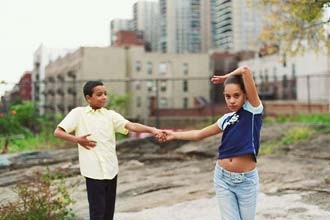Howl's Moving Castle, Mad Hot Ballroom
Howl's Moving Castle
Dir. Hayao Miyazaki; writ. Diana Wynne Jones (novel), Miyazaki; feat. (voices) Emily Mortimer, Christian Bale, Lauren Bacall, Jean Simmons, Billy Crystal (PG)
Animator Hayao Miyazaki is often called "the Japanese Disney," a comparison that's about half accurate. As an auteur, Uncle Walt can't hold a candle to his modern counterpart.
In Howl's Moving Castle, the master has his way with a story by Diana Wynne Jones: Young Sophie is turned into a spinster by a witch's curse. Seeking to undo the spell, she takes up with a vain, young wizard who has his own strange cross to bear. With a challenge at every turn, she becomes more assertive and energetic in old age than she ever was as a teenager.
| Japanese animator Hayao Miyazaki's latest film, Howl's Moving Castle, tells the tale of a young girl turned into an old crone and a castle with the power to move through time and space. |
For some viewers, the most wonderful thing in this film is the moving castle itself, an overgrown, cobbled-together thing that walks through the countryside on mechanical legs. But the castle isn't nearly as entrancing as its front door, which presents different views depending on how it is opened. The castle exists in many places at once, and this twisting of space and time - of reality, fantasy, and dreams - is central to the film's charm.
Despite the rave reviews, Howl's Moving Castle is not as thoroughly satisfying as some of Miyazaki's earlier work. Still, it's the kind of movie that transcends mere entertainment; Miyazaki's world is in the league of Lewis Carroll's or Dr. Seuss's, and even one of his less successful efforts boasts an unmistakable glow.
Mad Hot Ballroom
Dir. Marilyn Agrelo (PG)
Give a filmmaker a bag full of puppies and a box of cute powder, and it's unlikely she would come up with a more crowd-pleasing film than Mad Hot Ballroom, which opened last week after many previews that elicited adoring "aw"s and appreciative laughter. But while the movie works the cute factor hard, it stops short of cloying; there are enough short glimpses of unvarnished city life here to keep the film real.
| It's not as captivating as Spellbound, says John DeFore, but Mad Hot Ballroom captures enough real city life and class consciousness to rise above mere sweetness. |
This documentary follows a New York program in which public schools give free ballroom-dance classes to pre-teens, who then compete against schools from other boroughs. Privileged TriBeCa tots square off against Brooklynites and Harlem youngsters, and the movie squeezes in a tiny bit of class consciousness among the merengue steps.
The obvious comparison here is the very successful Spellbound; Mad Hot is less perfect in many ways but is sure to entertain the fans of the earlier doc. The crew's approach to this contest (which involves quarterfinals, semifinals, and a grand showdown on different dates) doesn't provide the who-will-win drama of Spellbound. As the contests unfold, there's little doubt who will win. And the number of kids involved here means that we won't get to know them as we did the other film's brainiacs.
But by the end, we have seen grace and style from kids who should be awkward; we've seen the difference between competitors who try to win and those who thrill to the event itself. Surely that's enough to make this tango worthwhile.



